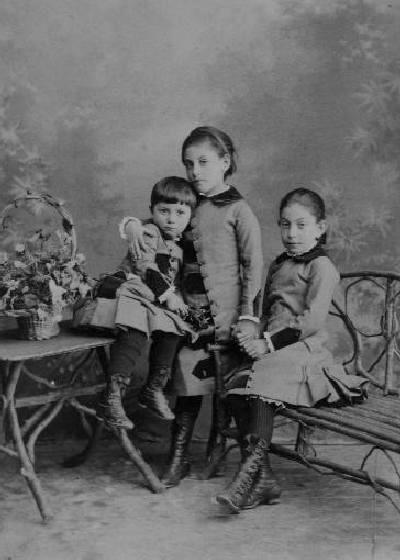
German Boys' Clothes: Dresses--Coordinated Outfits

Figure 1.--This image is unidentified, except that it was German. All we know is that the studio was Otto Reitmeyer located in Munich. The portrait was taken in München (Munich) about 1875. Note that the younger brother is dressed identically with his older sisters. All three wear dark long stockings. The only differebce we can see is that the little boy seems to be wearing long underwear under his long stockings. We would guess the children to be about 3/4-9 years old. Notice the body language in the portrait, suggestig a very close-knit loving family.
|
|
Parents, we assume mostly mothers, liked to dress all their children in the same outfits. We notice this in other countries as well. It seems especially popular in Germany, but that may just becuse we have acquired a larger German archive than that for many other countries. There were a variety of alternatives. Some times there were out outfits for the girls and other outfits for the boys. Sometimes these outfits could be coordinated. sailor styling was especially useful for this approach. Some mothers wanted all the children in exactly identical outfits. It was not considered proper for girls to wear pants, but younger boys could wear dresses. Thus if a family had older girls and younger boys, the etire family for a few years could be dressed just the same. Of course this could only be done for a few years, essentially until the oldest boy reached school age. We do not see a lot of family photographs showing this convention, but we see enough of them to known that it was an accepted comvention in the 19th century. Most if the coordinated dress images we have found are from the 19th century. We notice one 20th century image that seems rather unusual, an unidentified brother and sister, perhaps in the 1920s. We are not sure yet how to interpret it.
Popularity
Parents liked to dress all their children in the same outfits. We assume mostly mothers were involved here, but that is just a guess at this time. We notice this in other countries as well. It seems especially popular in Germany, but that may just becuse we have acquired a larger German archive than that for many other countries. We see quite a number of families all dressed in sailor suits. The alternative of dressing the boys in the family identically and the girls in other identical outfits seems especially popular.
German mothers had all sorts of way of coordinating how the children were dressed. There were a variety of alternatives mothers could adopt. Some times there were out outfits for the girls and other outfits for the boys. Sometimes the outfits for all the children were identical or coordinated in some way. Sailor styling was especially useful for this approach. Some mothers wanted all the children in exactly identical outfits. It was not considered proper for girls to wear pants, but younger boys could wear dresses. Thus if a family had older girls and younger boys, the etire family for a few years could be dressed just the same. Of course this could only be done for a few years, essentially until the oldest boy reached school age. We have no written information on this, but we have begun to collect some images.
Chronological Trends
We do not see a lot of family photographs showing this convention, but we see enough of them to known that it was an accepted comvention in the 19th century. Most if the coordinated dress images we have found are from the 19th century. We notice one 20th century image that seems rather unusual, an unidentified brother and sister, perhaps in the 1920s. We are not sure yet how to interpret it. By the 1920s it was quite unusual to see a boy this old wearing a dress.
There are no written conventions as far as we know about boys in large families wearin dresses. There seem to have developed, however, some unwritten conventions. With younger families, all the children might be outfitted in dresses, especially if the older children are girls. In large families, all the children below a certain age might be outfitted in dresses. In both cases the mother might choose identical outfits. This is helpful to know when trying to assess the gender of the children in old photographs where the individuals are not identified. There are many indicatos that can help such as hair style and props. One indicator that may prove helpful associated with coordinated outfits is tht in smaller families we suspect that a younger brother would not wear outfits coordinated with a sister if there was a brother in the family. This may have been the case if he only had older sisters, but we believe not if he had an older sister and brother.We can not prove this and of course mothers were endlessly creative, but we suspect tht this was the case.
HBC

Navigate the Boys' Historical Clothing German pages:
[Return to the Main German dress page]
[Return to the Main breeching page]
[Return to the Main coordinated dress page]
[Return to the Main German family page]
[German choirs]
[German youth organizations]
[German school uniforms]
[German royalty]
[German sailor suits]
[Lederhosen]
[Ethnic]
[Tights]
[Long stockings]
Navigate the Boys' Historical Clothing Web Site:
[Introduction]
[Activities]
[Biographies]
[Chronology]
[Clothing styles]
[Countries]
[Girls]
[Topics]
[Bibliographies]
[Contributions]
[FAQs]
[Glossaries]
[Images]
[Links]
[Registration]
[Tools]
[Boys' Clothing Home]
Created: July 4, 2003
Last updated: 8:40 PM 11/9/2008



